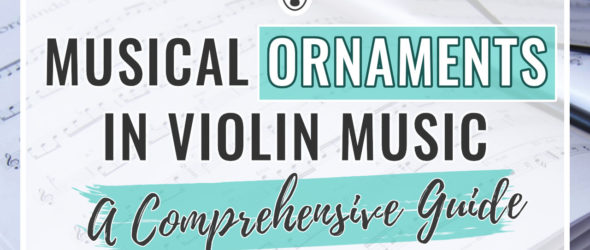
Read on to find out what music ornaments are there and how to play them on the violin!
Do you ever wonder how you can add your personal touch to a violin piece? Or listen to musicians improvising by spontaneously adding notes that weren’t written by the composer? This is how musical ornaments first appeared in music. In your violin journey, you will come across musical ornaments in many violin or fiddle pieces.
So, what are those embellishments? What is their role in violin music and how can you easily play them? Let’s go!
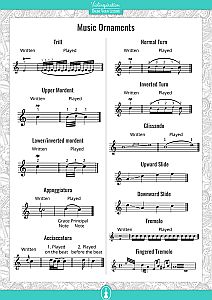
Music Ornaments
Download Free PDF Chart
What is the Purpose of Music Ornaments in Violin Music?
The main purpose of musical ornaments is to add interest to a simple melodic line, give musicians the freedom to add their personal touch, and show off their virtuosity.
Let’s take a look at two music theory terms that are important in understanding musical ornamentation:
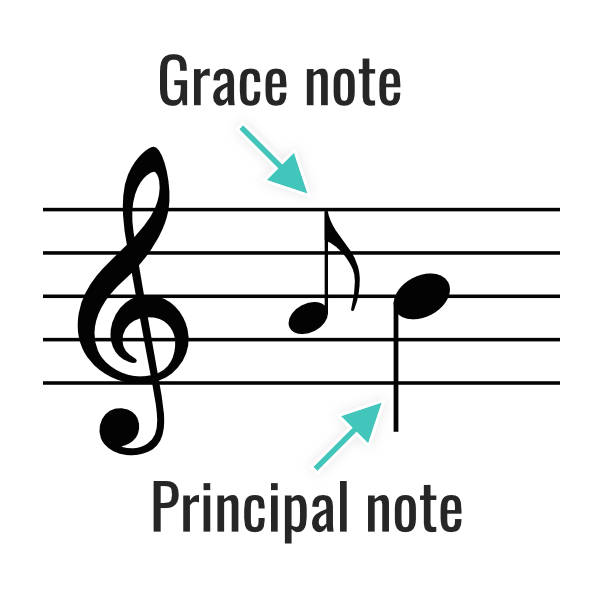
Principal note
A principal note or main note is the primary note of a melodic line and it is part of the chord accompanying the melody.
Grace note
Grace notes are small notes preceding a principal note. They are typically played quickly before the principal note. Grace notes are also called embellishments or auxiliary notes and they aren’t a part of the accompanying chord.
Trill
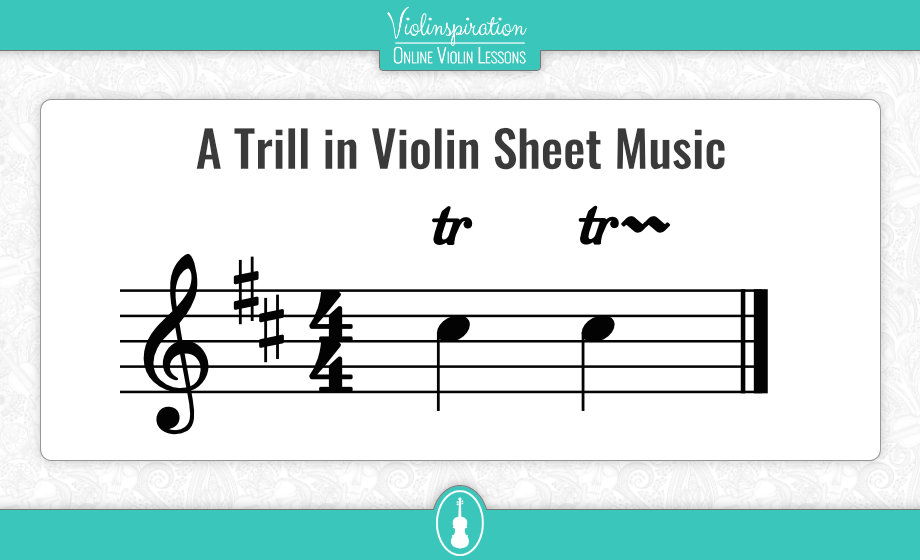
The trill is a two-note pattern type of ornamentation. It is basically a rapid alternation between two pitches. Trills are marked with a tr above the principal note and a wavy line next to it indicating the length of the trill.
Trills were the most popular musical ornament among composers from the Baroque to the Romantic era who wanted to create vivid imagery, add excitement or tension to a long note, and indicate the closing of a melodic phrase.
Example of Trills in Violin Performance
Probably the most well know example of trills in violin music is the Devil’s Trill by Tartini.
In the next example, listen to how Vivaldi is using trills to imitate bird sounds:
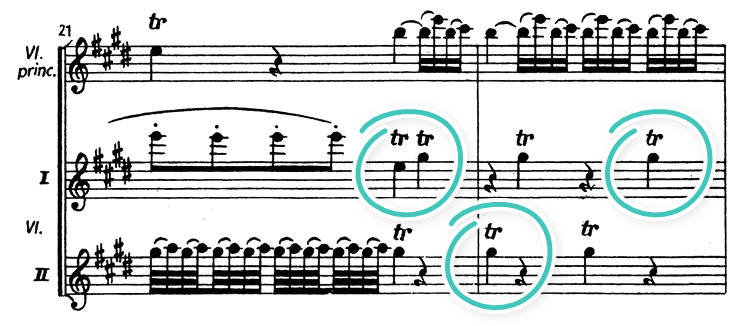
How to Perform a Trill on the Violin
The trill relies on finger speed and articulation. To get instant results, follow the steps below:
- Place the first finger on the D string on the E note (principal note)
- Without lifting the first finger, place the second finger on the D string on the note F#
- Energetically lift the 2nd finger and then place it down again
- Now try to play a continuous E F# E F# E F# for two beats.
That’s it, you’ve just played a trill!
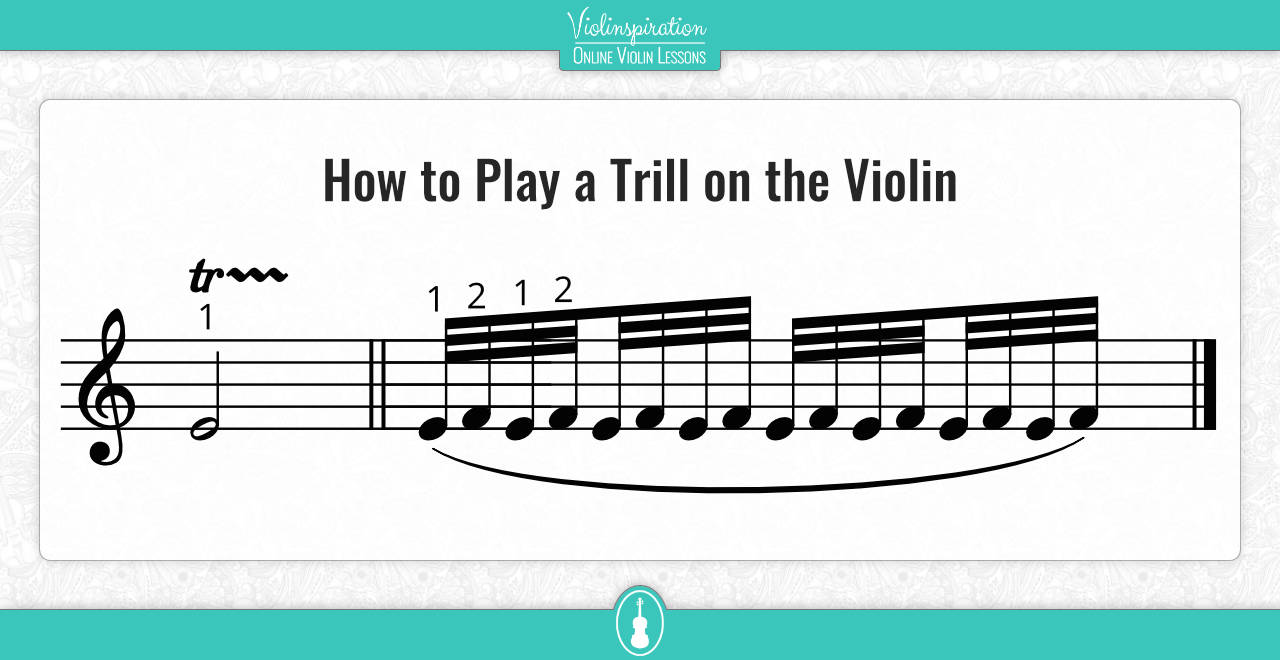
For more details on executing trills and a free set of exercises, make sure to check out my easy guide to violin trills.
Mordent
Mordents are similar to trills but their main difference is the length of the grace note. They also are a three-note pattern ornamentation.
There are two types of mordents; lower mordents, aka inverted mordents, and upper mordents.
Upper mordents are indicated with a wavy line above the note and inverted mordents with a wavy line and a vertical line through it. Upper and lower mordents can either add flair and playfulness to a melodic line or a dramatic touch. They were widely used in Baroque music.
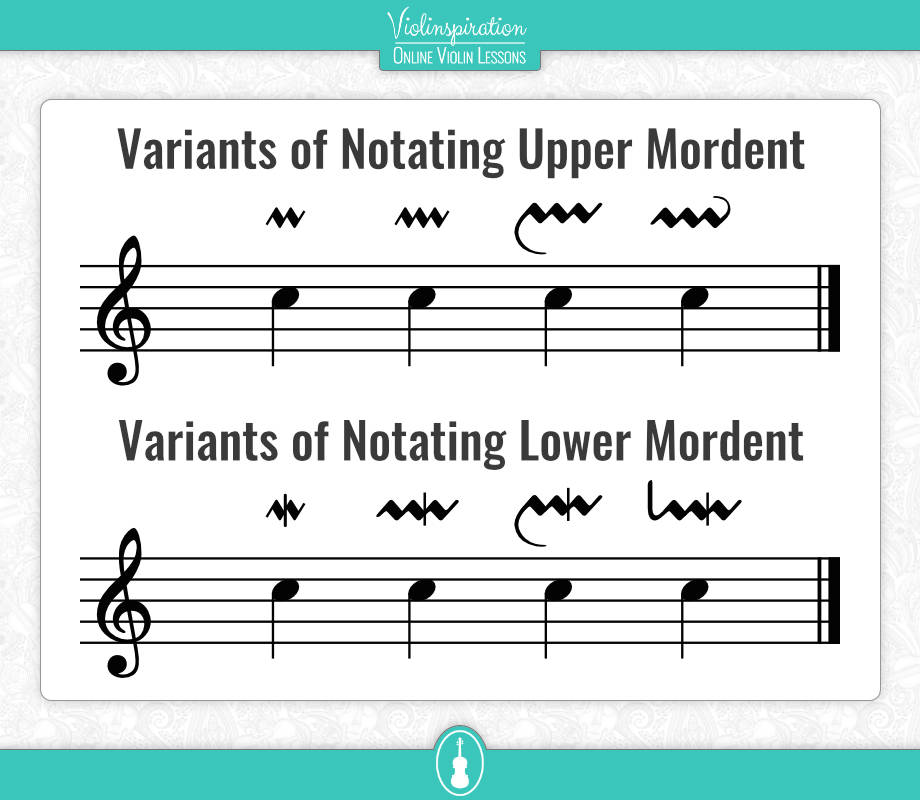
Example of Mordents in Violin Performance
How to Perform a Mordent on the Violin
1) Upper mordent
- Place the 1st finger on the A string on note B (main note) and keep it down
- Start bowing the B, drop the 2nd finger on the C note (grace note), and then instantly lift the 2nd finger energetically off the string
- What you should hear is a B C B on one beat
Well done, you just performed an upper mordent!
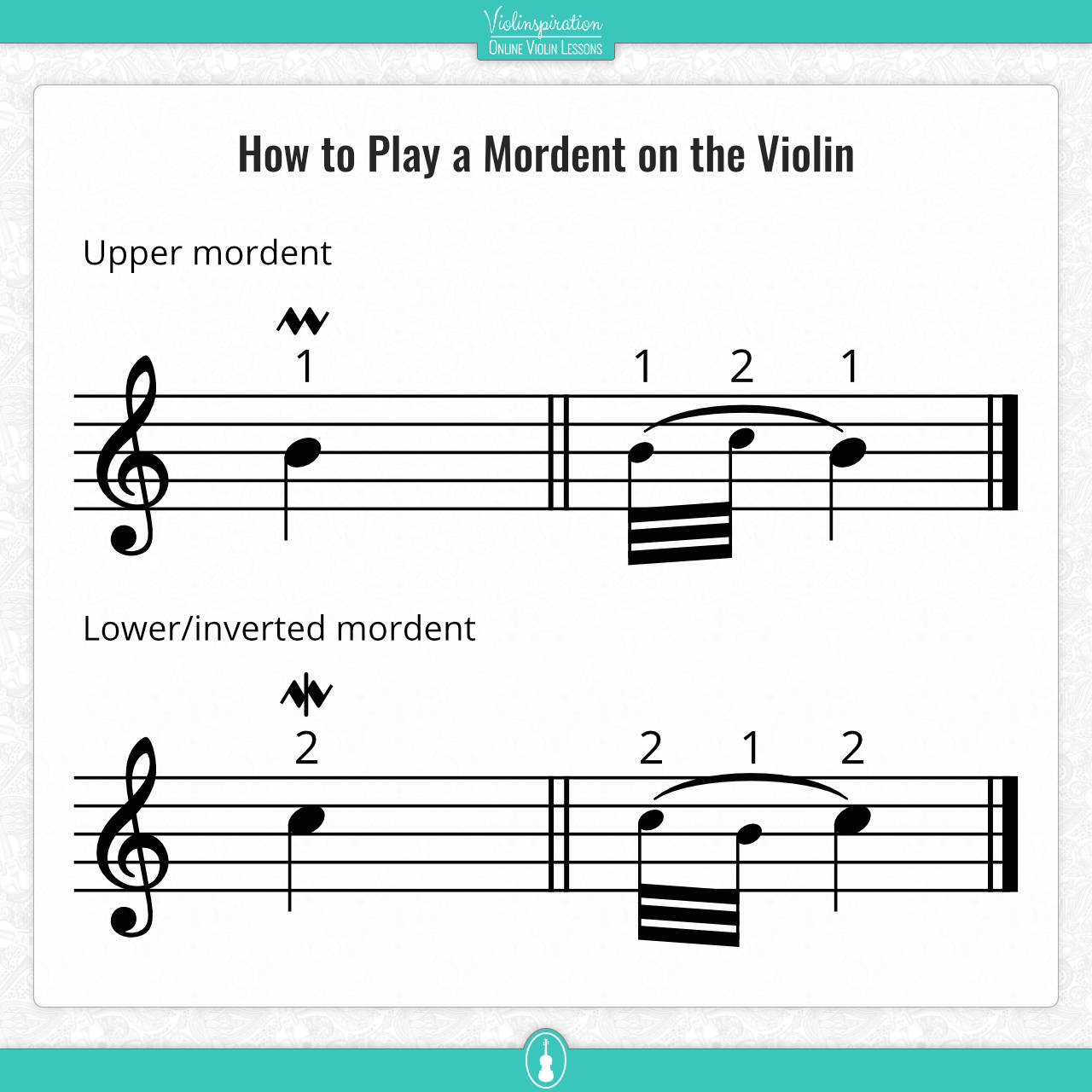
2) Lower/inverted mordent
- Place the 2nd finger on the A string on the C note with the 1st finger already on the B
- Start bowing on the A string and energetically lift the 2nd finger and then drop it back to its starting position
- What you should hear is C B C on one beat
Appoggiatura
In sheet music, the appoggiatura is a small slurred embellishment note written before the principal note. In terms of duration, it lasts for half the duration of the principal note. You always play an appoggiatura on a strong beat, which adds harmonic tension to a melodic line.
The Appoggiatura falls under the grace notes category, originating during the Baroque period. It can be found in many music genres but it is most prominent in classical music.
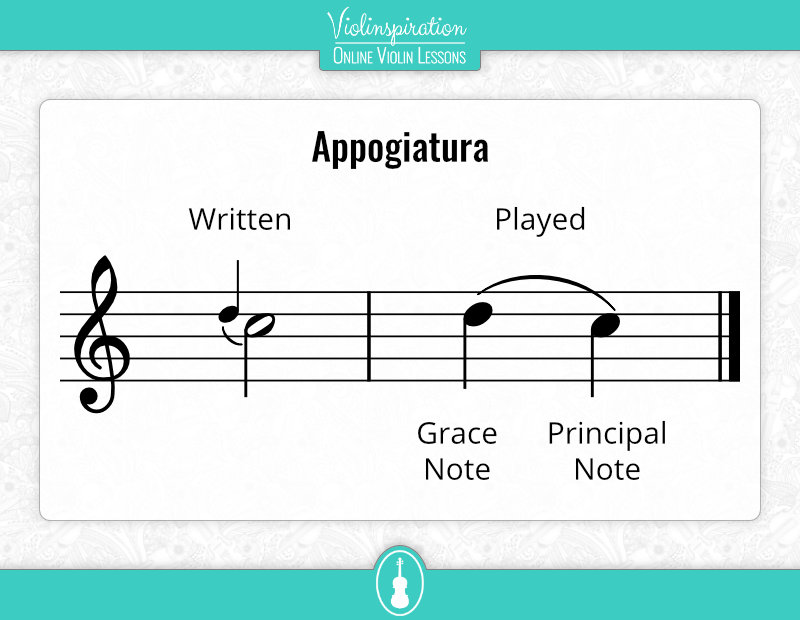
Example of Appoggiatura in Violin Performance

How to Perform an Appoggiatura on the Violin
The main note is a C half note.
- Start with the 2nd finger on the C note on the A string
- Place the 3rd finger on the D note on the A string without lifting the 2nd finger
- Count one-two-three-four. Play the D on the one and the C on the two
- What you should hear are D C quarter notes.
Good job, you just played a long appoggiatura!
Check out this blog post to learn more about the appoggiatura.
Acciaccatura
Acciaccatura is a grace note and sounds like a short appoggiatura. The acciaccatura sign is a small note slurred to the principal note with a slash through the stem. It can be played on a strong beat or quickly before the main note, borrowing time from the previous beat.
Acciaccatura was extensively used in Baroque music and appears in various music styles from classical music to country and folk. Acciaccaturas are great for adding elegance and joy to a melodic line.
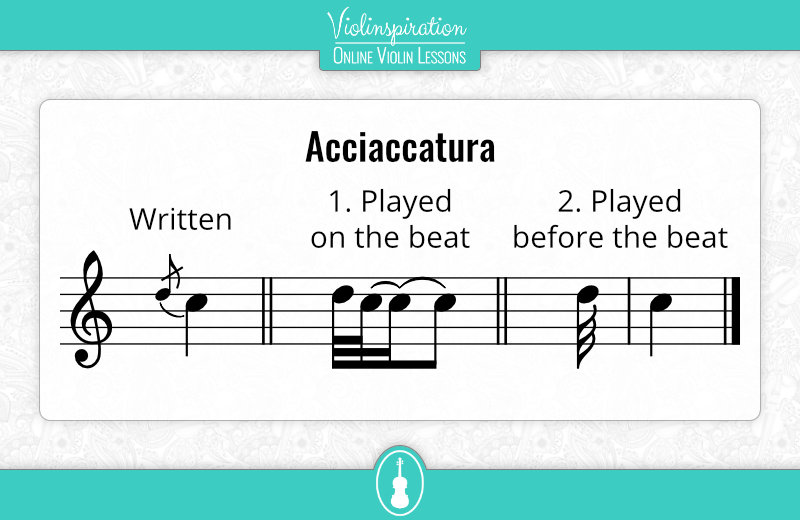
Example of Acciaccatura in Violin Performance

How to Perform an Acciaccatura on the Violin
Playing an acciaccatura is like playing a short appoggiatura. Let’s say the main written note is a C quarter note and the acciaccatura is a D note.
- Place the 2nd finger on the C note on the A string
- Place the 3rd finger on the D note on the A string without lifting the 2nd finger
- At the moment you start bowing the A string, energetically lift the 3rd finger off the string. So your task is to play the upper note D very quickly before the click of a metronome and then the C note as written. In that way, the C note is on the strong beat
- To play the D note on the strong beat, start bowing the D and lift the 3rd finger a little bit later – on the click of a metronome.
You just played an acciaccatura, you’ve got this!
Turns
The turn is a four-note pattern type of music ornament. It involves the written note, the upper mordent, the written note again, and lastly the lower mordent. It is indicated with a horizontal “S” symbol above the main note.
Turns are great for making a melody sound complex and intriguing to the listener. They were extensively used from the Baroque to the Romantic period but they’re common in folk music as well.
There are two types of turns:
- Normal Turns – Horizontal “S” symbol
- Inverted Turns – Horizontal “S” symbol with a vertical line through it
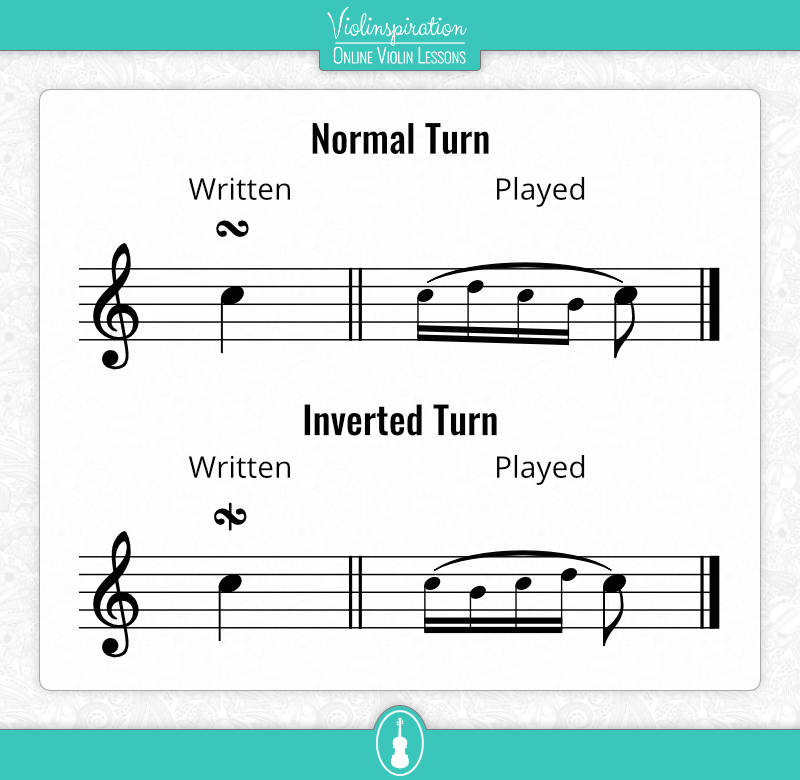
Example of Turns in Violin Performance
Listen to how the violin adds turns to embellish the melodic line.
Listen to an original Baroque performance:
How to Perform a Turn on the Violin
1) Normal Turn
The main note is the C on the A string
- Place the 1st finger on the B note on the A string, the 2nd finger on the C note, and the 3rd finger on the D note without lifting any finger
- The C in the main note, the D is the upper mordent and the B is the lower mordent
- Start bowing the C note, then drop and lift the 3rd finger energetically. Lastly, lift and drop the 2nd finger quickly
- What you should hear is C D C B C
- Practice this pattern with a metronome until all four notes are equal in duration and fit on one beat
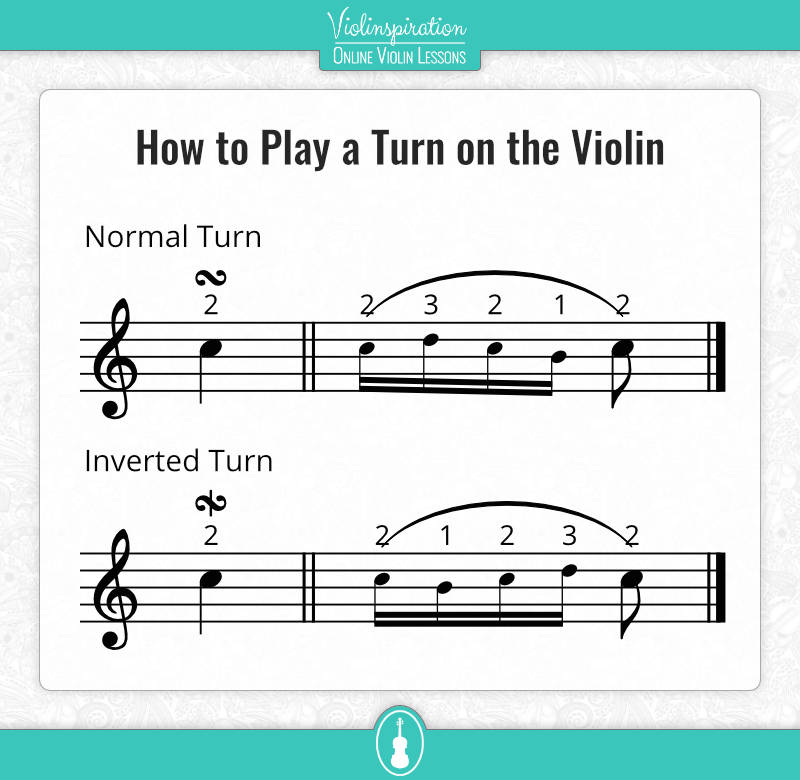
2) Inverted Turn
- Place the 1st finger on the B note on the A string, the 2nd finger on the C note, and the 3rd finger on the D note without lifting any finger
- Start bowing and play the 2nd finger (main note). Lift and drop the 2nd finger energetically. While the 2nd finger is lifted, you hear the note B. Lastly, drop and lift the 3rd finger energetically
- What you should hear is C B C D C
- Practice this pattern with a metronome until all four notes are equal in duration and fit on one beat
Glissando

Glissando derives from the French word “glisser” which translates to “glide” and as it suggests, glissando is a smooth slide from one specific note to another. It is indicated with a line that starts on the initial note and goes to the desired note, either upwards or downwards, accompanied by the abbreviation “gliss” although there are also other ways you may see it in music notation. It is used to express passion if played slowly and virtuosity if played quickly.
Glissando emerged in the violin repertoire during the Romantic era and appears in various styles such as gypsy music, jazz, blues, and folk.
Example of Glissando in Violin Performance
How to Perform Glissando on the Violin
- Place the 2nd finger on the note F on the D string
- Slide the 2nd finger forward. Your finger should lie on the string
- After getting familiar with the motion of the 2nd finger sliding forward, try sliding your finger backward. Your finger should be round and pressing the string when pressing the F note.
Follow my easy guide to nail the glissando technique: Violin Glissando – Easy Violin Lesson.
Slide
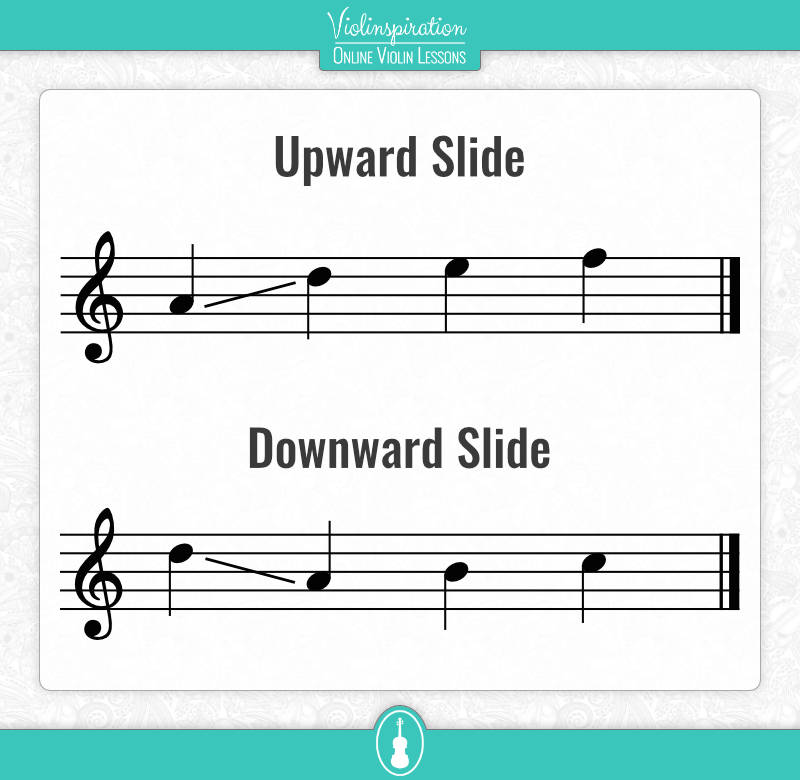
The Slide is a fast finger slide like a short glissando, starting from one note or two below the desired written note. In sheet music, slides may be indicated with a short straight line leading to the desired note or not notated at all, letting the musician add them depending on their taste, technical skills, and music style. Slow slides add expressiveness and fast slides can add playfulness.
Slides were widely used by romantic composers and they are stylistically important in genres such as jazz, blues, and folk.
Example of Slides in Violin Performance
Fingered Tremolo
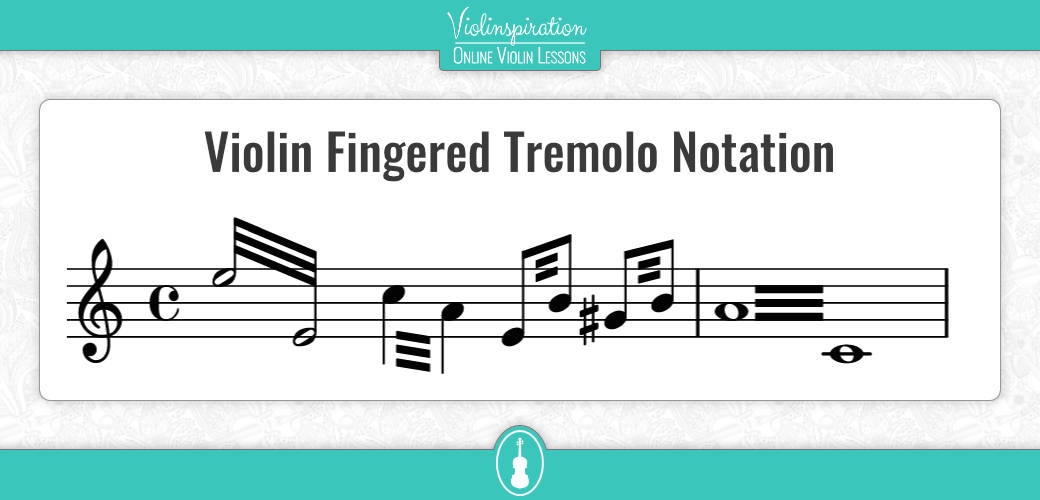
Fingered tremolo is a rapid alternation between two notes, like a trill, but the notes are three or four steps apart. The fingered tremolo notation is multiple lines on the notes or a zig-zag line on the stem of the notes.
This technique is often used to create a mysterious or suspenseful atmosphere in a piece of music. Originating in the classical era, the ornamentation was used widely in operas and classical symphonies.
There are two types of fingered tremolo; unmeasured tremolo and measured tremolo.
- Unmeasured Tremolo
The notes are repeated as quickly as possible within a certain amount of beats/duration.
- Measured Tremolo
The notes are repeated rhythmically, based on the subdivision of the beat.
Example of Fingered Tremolo in Violin Performance
How to Perform Fingered Tremolo on the Violin
Performing fingered tremolo is like doing a trill.
- Let’s say the main notes are a B and D
- Place the 1st finger on the B note on the A string and the 3rd finger on the D note
- Rapidly alternate between B and D like doing a trill
- This is unmeasured fingered tremolo
Irish Music Ornaments
Music ornamentation would be incomplete without the Irish fiddle! Irish musical ornaments look and sound a lot like the ones already mentioned in this post but they are used in a different harmonic and rhythmic context to add that unique Irish flavor we all love!
Irish Music Ornaments:
- Triplets
- Cut/Double Cut
- Tap
- Pat
- Long Roll
- Double Roll/Short Roll
- Crans
- Upward/Downward Slide
- Double Stops
Here is a detailed guide on how to play Irish musical ornaments and make sure to download your copy of the Irish ornaments cheat sheet below!
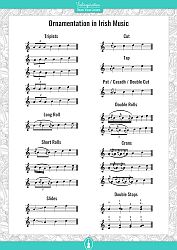
Ornamentation in Irish Music
Download Free PDF Chart
One Step Closer to Expressiveness with Music Ornaments
Music ornaments are a great tool to add to your music arsenal. Whether it’s a simple mordent or a complicated turn, let your imagination flow and experiment with adding grace notes to the pieces you perform.
Although music ornamentation might seem intimidating at first, it is easy to get it right with some practice. Using music ornaments can take your expressiveness to a whole new level and I hope this post helps you take the first step!























